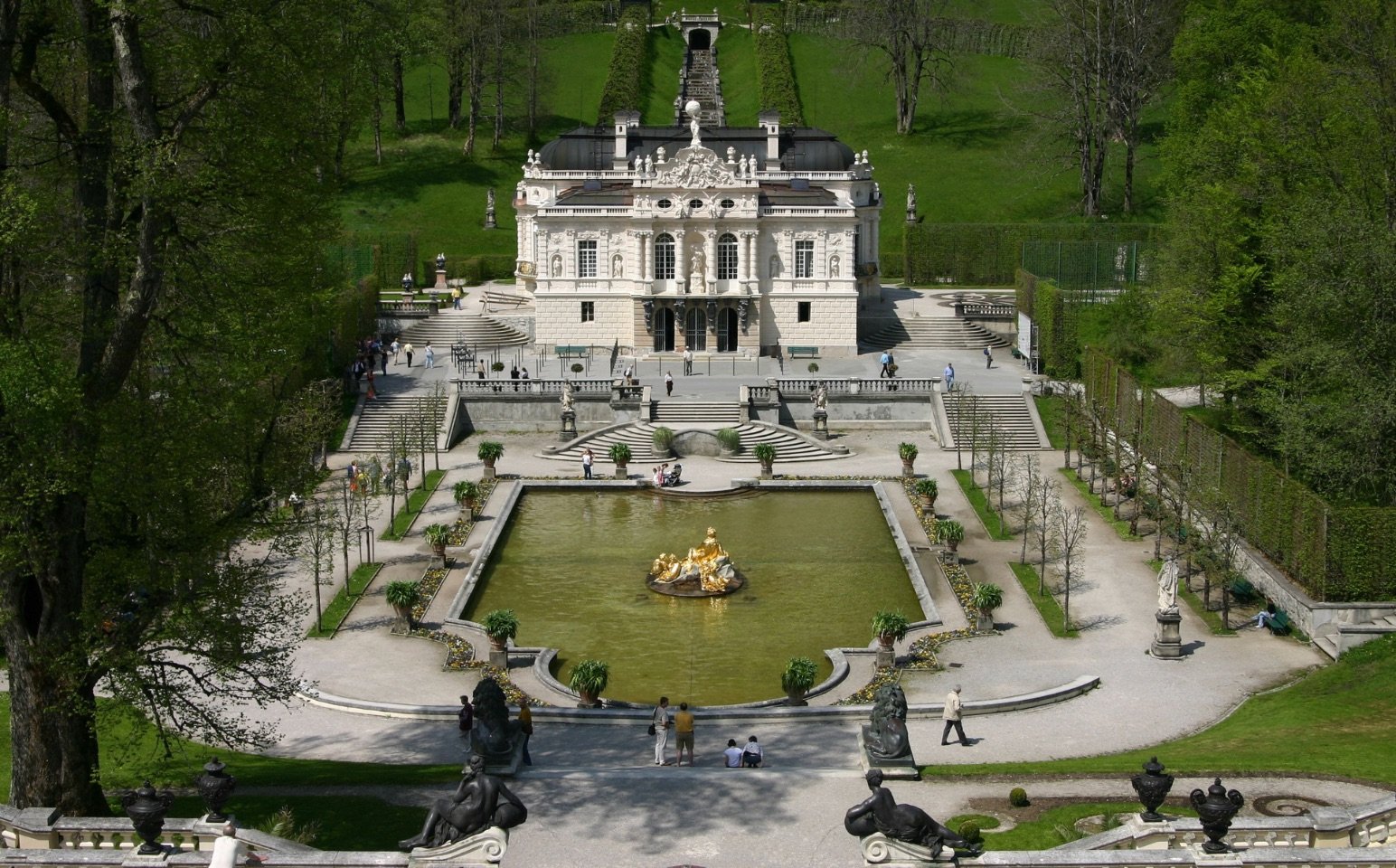Day 592 Garmisch-Partenkirchen and Dachau
Driving to Garmisch-Partenkirchen
Linderhof Palace
We drove out of the Black Forest toward Garmisch-Partenkirchen. This took us toward the southeast corner of Germany, through farm after farm, vineyards, and great patches of green so verdant it felt as though a carpet had been laid there. In between lay large patches of brilliant yellow flowers growing more canola oil. This was the view for two hours, and then far away, we could see the white edges of the alps.
After briefly passing through a small patch of Austria we found our hotel and settled in. We were disappointed in Garmisch-Partenkirchen, but it wasn't the town's fault. It was the weather. A vagabond friend, Patty Linde, had recommended the town as one of the prettiest places in Germany, but unfortunately, its beautiful mountains were mist-veiled by a soaking, cold rain all the three days we were there. That silenced any chance of hiking, or even much wandering of the town. One of Garmisch's great assets is the fine alpine mountains that surround it. The same mountains that were chosen to be the location for the first skiing events for the Winter Olympics in 1936, the year Adolf Hitler refused to shake the hand of Jesse Owens, a black man, when he won the gold medals for the 100 and 200 meter races. But we saw little of them.
The weather made us rethink our explorations. We decided to keep our car a day longer and use it to explore one of the three famous castles of "Mad King Ludwig" II, former king of Bavaria from 1864 until his death in 1886.
Ludwig was famous for the lavish castles he built: Neuschwanstein Castle, Linderhof Palace and Herrenchiemsee. Neuschwanstein was the inspiration for Walt Disney's iconic castles in the fairylands he created around the world. When we realized how close we were to Dachau, Nazi Germany's first concentration camp, and one of its most infamous, we decided we could explore both in one day.
On the 12th, our car weaved us through verdant farmland and we rose into the fog and rain of Linderhof Palace.
Ludwig's interest in his palaces seems to have been less about his love of opulence and more about his daydreaming, fairytale, loving proclivities. (He and Walt Disney would have gotten along famously.) He paid for all of his castles out of his own large pockets. They became ways for him to express himself. He also built a theater to show off the works of all of Europe: operas, ballet, plays by Molière and Shakespeare. He adored Richard Wagner's work. All of this made him rather a poor politician and royal leader. Increasingly he forsook issues dealing with the military, economics and other political issues, and retreated to his palaces. That led to his undoing when his ministers eventually had him legally declared insane and ousted him. Very soon afterwards he died under mysterious circumstances. The mystery has never been truly solved.
Horrors of Dachau
After Linderhof we took the highway north to Dachau, the utter opposite of Ludwig's fairytale castles.
Dachau’s Museum is overwhelming, a powerful example of man’s inhumanity to man, woman and child. The entire camp constitutes the museum, and that reveals the shocking scale of the killing and torture. In the long and rambling buildings, the story of the earliest days of Hitler’s rise sets the stage for the incremental way in which the Third Reich moved to systematically obliterate millions of lives. Though only the people who survived it can really know the horrors of the place, the museum gives you a taste of the powerlessness, humiliation, and fear it created. I stood looking at the empty bathrooms that they had arranged there for the inmates and imagined them crammed with people dying by inches, being constantly barked and screamed at naked, vulnerable, attempting to do the most basic human tasks. The feeling creeps into you: You mean nothing. You have no power, no purpose, and are completely and constantly at the whim of the camp's angry guards. Images of crowds, workhouses, broken men, women and children, hollow-eyed and starved are all there as you walk the buildings, and finally, at the end, are the stark images of bodies stacked like cord wood, a fine place for the grim reaper.
Half way through, Cyndy stopped with tears in her eyes, and said, "I can't take any more." I plodded through, increasingly stunned and saddened. I could not wrap my mind around the dread and brutality of the place and struggled to imagine how the good people of Germany had allowed such a thing to happen on such an immense scale. Painful as it was to witness, it was clear the museum was a necessary testament; a reminder that something like this must never happen again.












